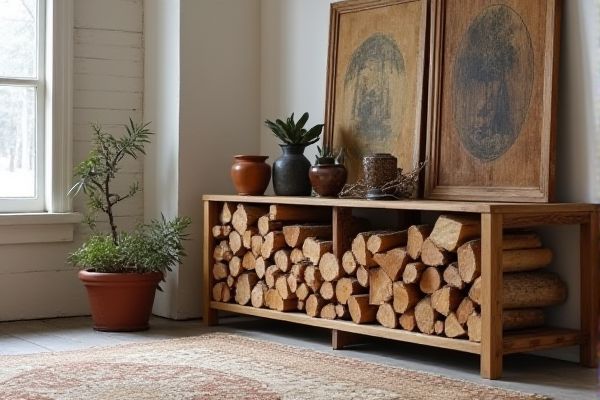
A wood rack is designed for neatly stacking and air-drying firewood, often featuring a larger capacity and open sides for ventilation, while a log holder is typically smaller and used for transporting or temporarily storing logs near your fireplace or stove. Understanding these differences will help you choose the best option for your wood storage needs; explore the rest of the article to find out which suits your requirements best.
Table of Comparison
| Feature | Wood Rack | Log Holder |
|---|---|---|
| Purpose | Storage and organization of firewood | Temporary holding of logs for easy access |
| Material | Typically metal or wood frame | Usually metal or wrought iron |
| Capacity | High - holds multiple pieces stacked | Medium - holds fewer logs |
| Design | Open frame, allows airflow | Compact, often decorative |
| Indoor Use | Less common, usually outdoor | Common; designed for indoor use near fireplaces |
| Portability | Less portable due to size | Often lightweight and portable |
Introduction to Wood Racks and Log Holders
Wood racks and log holders serve the essential function of organizing and storing firewood efficiently, preventing moisture damage and ensuring proper airflow. Wood racks are typically larger structures designed for outdoor use, accommodating substantial firewood quantities, while log holders are more compact, often used indoors for easy access and neat stacking. Understanding their purpose and design helps in selecting the best option for wood storage based on space and usage needs.
Key Differences Between Wood Racks and Log Holders
Wood racks are typically larger, designed to store significant quantities of split firewood neatly stacked for drying and seasoning. Log holders are more compact, intended to hold smaller amounts of logs for easy access and immediate use near fireplaces or wood stoves. The main difference lies in capacity and placement: wood racks emphasize long-term storage, while log holders prioritize convenience and portability.
Materials Used in Wood Racks vs Log Holders
Wood racks commonly feature durable materials such as steel, wrought iron, or treated hardwood, designed to support heavy loads and withstand outdoor elements. Log holders often incorporate lighter metals like aluminum or coated steel, combined with simpler wooden accents, prioritizing portability and aesthetic appeal. Choosing the right material impacts Your wood storage's longevity and functionality based on whether you need sturdier support or easy maneuverability.
Design and Aesthetic Appeal Comparison
Wood racks offer a streamlined, minimalist design ideal for modern or rustic interiors, emphasizing functionality with clean lines and natural timber finishes. Log holders often present a decorative touch, crafted with wrought iron or intricate metalwork that adds an artistic flair to your fireplace area. Your choice between wood rack and log holder should balance practical storage needs with the desired aesthetic impact on your living space.
Storage Capacity and Functionality
Wood racks typically offer larger storage capacity, designed to hold substantial amounts of firewood in an organized, ventilated manner to ensure efficient drying and easy access. Log holders are usually smaller, more compact solutions ideal for indoor use, focusing on convenience and aesthetic appeal rather than bulk storage. Both serve distinct purposes: wood racks maximize functionality for outdoor woodpile management, while log holders enhance indoor wood storage with limited capacity.
Indoor vs Outdoor Usage
Wood racks designed for outdoor usage are typically made from weather-resistant materials like galvanized steel or treated wood, ensuring durability against rain, snow, and sun exposure. Log holders, often crafted from wrought iron or lighter woods, suit indoor settings better due to their decorative appeal and limited weather protection. If you're storing firewood near your fireplace, choosing a log holder enhances both functionality and indoor aesthetics, while wood racks excel in outdoor environments by keeping wood dry and off the ground.
Durability and Weather Resistance
Wood racks made from treated hardwood or metal frames exhibit superior durability and weather resistance, ensuring long-lasting performance in various outdoor conditions. Log holders, often crafted from lighter materials like wrought iron or steel without protective coatings, tend to be less resistant to moisture and rust over time. Choosing a wood rack with weatherproof finishes significantly reduces maintenance and protects logs from environmental damage.
Ease of Assembly and Installation
Wood racks typically feature pre-drilled holes and straightforward designs, making assembly and installation quick and user-friendly. Log holders often come in simpler, compact forms that require minimal setup, ideal for easy placement near fireplaces or wood stoves. Both options balance convenience, but wood racks generally offer more structural support while maintaining easy assembly for efficient storage.
Price Range and Value for Money
Wood racks typically offer a wider price range, from budget-friendly options starting at $30 to high-end models exceeding $200, providing versatility for different budgets. Log holders, often simpler and more compact, usually cost between $20 and $100, delivering great value for small-scale storage needs. Your choice depends on the amount of wood you need to store and whether you prioritize capacity or cost efficiency.
Choosing the Best Option for Your Needs
Selecting between a wood rack and a log holder depends on your storage needs and available space. Wood racks offer larger capacity and better air circulation, making them ideal for long-term outdoor storage, while log holders provide a compact, stylish solution suited for indoor use or smaller areas. Consider factors such as durability, material quality, and ease of access to ensure optimal firewood organization.
 homyna.com
homyna.com